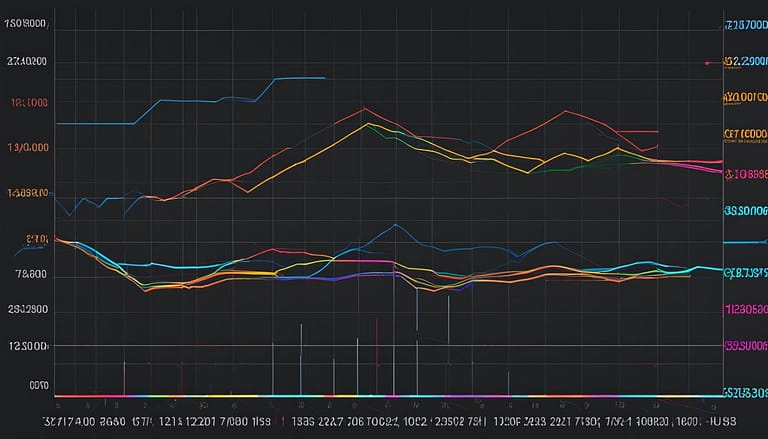The Evolution of Cryptocurrency Trading Platforms
With the inception of Bitcoin in 2009, cryptocurrency markets have embarked on an extraordinary journey, shaping a new era in the financial domain. Canadian and global investors alike have witnessed the rapid evolution of trading platforms, transforming from mere facilitators to sophisticated digital asset exchanges. This metamorphosis has been propelled by the market’s insightful response to the oscillating waves of digital currencies. The resilience demonstrated by these platforms, amidst the heady fluctuations that are characteristic of these novel assets, exemplifies the dynamic nature of our era’s financial innovation.
Indeed, as the digital realm burgeoned, so too did the quest for robust, transparent, and user-centric trading mechanisms. Platforms catering to the cryptocurrency space have steadily matured, navigating through a complex landscape of regulatory expectations and privacy considerations. This evolution reflects a poignant chapter in the annals of digital commerce, with exchanges at the heart of the transformation, converging at the intersection of technological prowess and economic foresight.
Key Takeaways
- Initial expansion of cryptocurrency platforms mirrored the rapid growth of Bitcoin and other digital currencies.
- Volatility in the cryptocurrency markets has necessitated trading platforms to adopt enhanced security and regulatory measures.
- The progress of digital asset exchanges showcases innovative responses to regulatory challenges, such as KYC and AML protocols.
- Cryptocurrency exchanges have become more sophisticated, prioritizing both the stability of digital assets and the ethos of decentralization.
- The continuous evolution of trading platforms has significantly shaped the accessibility and functionality of the cryptocurrency market for Canadian investors.
The Early Days of Crypto Trading: A Volatile Start
As the first electronic transactions began to echo through the domain of digital currencies, the world witnessed a significant divergence from the established practices of the stock market. Indeed, the conception of the cryptocurrency bandwagon came with equal parts uncertainty and excitement. Early adopters were lured by the promise of decentralization and potential for large profits, while market veterans eyed the burgeoning asset class with a mix of intrigue and skepticism.
Initiation of Digital Asset Trading
The birth of cryptocurrency trading kicked off with much fanfare among technology enthusiasts and liberty-seeking individuals. Unlike the methodical pace of traditional trading, this new horizon was untamed and rapid, propelling Bitcoin into the spotlight. The surges in its price commanded the attention of the public, signaling a profound shift in the financial paradigm.
Market Response to Early Cryptocurrency Fluctuations
The volatile nature of digital assets was established early on, becoming characteristic of the sector. Particularly, Bitcoin’s volatility drew a stark comparison to the relative stability of the stock market. Despite the rollercoaster of price movements, the allure of high rewards saw many investors stepping up to the plate, eager to capitalize on the upswings and brave the downswings of cryptocurrencies through 2017’s dramatic price fluctuations.
Striving for Balance: Privacy vs. Transparency
The robust growth of the digital currency landscape has put cryptocurrency exchanges at the center of a privacy versus transparency debate. Adhering to KYC rules and AML regulations is becoming increasingly crucial as these platforms seek to prevent illicit activities while also protecting the personal information of their users. The interplay between confidentiality and accountability in the operation of cryptocurrency exchanges symbolizes a modern-day balancing act.
Adjusting to KYC and AML Regulations
In an environment shaped by the need for legitimacy and anti-fraud measures, cryptocurrency exchanges have been steering towards stronger regulatory compliance. This shift aligns them with conventional financial institutions, even as they work to maintain the innovative spirit of the digital assets market. Implementing KYC rules empowers exchanges to verify the identity of their clients, thus protecting the integrity of transactions and helping to prevent money laundering.
The Trade-Offs of User Information Privacy
The consequence of this regulatory embrace is a trade-off between user privacy and the security of the financial ecosystem. As exchanges collect more personal information, concerns rise over its protection and the risks associated with data breaches. The decision for users to engage with platforms imposing these requirements becomes a conscious choice of weighing the benefits of enhanced security against the advent of increased personal data exposure.
Below is a comparative analysis of how cryptocurrency exchanges approach the dichotomy of privacy and transparency:
| Features | Anonymity-Focused Exchanges | Regulation-Compliant Exchanges |
|---|---|---|
| User Identification | No KYC Requirements | Strict KYC Enforcement |
| Transparency Level | High | High (Public Ledger) |
| Risk Mitigation | Variable | Integrated AML Programs |
| Privacy Protection | Enhanced | Subject to Policy |
| Consumer Incentives | Limited to Privacy | Loyalty Programs and Rewards |
Finding the perfect equilibrium is an evolving pursuit for cryptocurrency platforms as they navigate the complex waters of financial regulation and user autonomy. As the industry evolves, a watchful eye on this balance will be integral in shaping a responsible yet forward-thinking digital economy.
Security Overhaul: Learning from Hacks and Thefts
The trajectory of digital finance has been punctuated by alarming incidents of security breaches within the cryptocurrency markets. Daunting episodes such as the notorious collapse of QuadrigaCX remind us that the need for robust cybersecurity measures and advanced encryption technologies should be at the forefront of decentralized finance. These historical ordeals have catalyzed a comprehensive overhaul of security protocols among trading platforms.
Since the Mt. Gox incident, there has been a notable swing towards safeguarding assets and fortifying exchange security infrastructures. The subsequent approach has been twofold. Firstly, exchange platforms have escalated efforts to integrate state-of-the-art cryptographic methods to secure transactions, and secondly, there has been a community-driven shift to personal hardware wallets, minimizing risks associated with online storage.
Below is an illustration of the security enhancements adopted by leading cryptocurrency exchanges in response to past heists:
| Exchange | Security Breach | Enhancements Post-Breach |
|---|---|---|
| Mt. Gox | 2014 Hack | Implementation of Cold Storage and Multisig wallets |
| Bitfinex | 2016 Hack | Partnership with security firms, upgraded encryption methods |
| Others | Various Breaches | Introduction of Insurance funds, enhanced user authentication protocols |
These amendments have underscored a systemic push towards not just preserving wealth but re-establishing trust within the global community of digital currency enthusiasts. They also signify an important chapter in the narrative of cybersecurity in QuadrigaCX-era digital finance, heralding new benchmarks for technology deployment in the sector.
The drive for improvement has not ceased, as continuous advancements in encryption technologies are being adopted by various players within decentralized finance. These aim not merely to combat and deter cyber threats but to proactively define the future of secure, resilient digital transaction systems.
Building Trust in Cryptocurrency Exchanges
The cryptocurrency community’s growth is largely contingent upon the ability to conduct secure transactions. Cryptocurrency exchanges have recognized this need and have steadily fortified their platforms with advanced encryption technologies to curtail the risks that come with trading digital assets. The impetus for these enhancements is not just theoretical—it reflects the aspirations of a community keen to ensure the integrity and continuity of its marketplaces.
Rising Demand for Secure Transaction Solutions
As more digital assets enter the financial ecosystem, users demand transaction mechanisms that protect their investments against malicious actors. Firms within the crypto space have taken this to heart, creating solutions that provide peace of mind for both new entrants and seasoned traders of the cryptocurrency community.
Introducing Robust Security Measures in Platforms
Initiatives by companies such as Boston-based Arwen showcase the considerable leaps made in securing cryptocurrency exchanges. Arwen’s protocol, for example, offers a layer of security that ensures users’ assets remain uncompromised—even in the unlikely event of an exchange breach. Such measures are integral to nurturing trust within the cryptocurrency community and highlight the significance of investment in state-of-the-art encryption technologies.
Below is a comparison of traditional and advanced security features implemented by cryptocurrency exchanges to assure their users of secure transactions:
| Security Feature | Traditional Approach | Advanced Solution |
|---|---|---|
| Data Encryption | Basic SSL encryption | End-to-end encryption with multi-signature wallets |
| Authentication | Two-factor authentication (2FA) | Biometric authentication and hardware security keys |
| Wallet Security | Custodial wallets | Decentralized, non-custodial wallets with enhanced private key protection |
| Transaction Verification | Manual checks and balances | Automated smart contract-based verification |
| Asset Recovery | Limited options for recovery | Protocols enabling asset recovery in the event of loss or theft |
With continuous advancements in security, the infrastructure of cryptocurrency exchanges is rapidly evolving, underlining the pivotal role of encryption technologies and innovative solutions in sustaining the burgeoning landscape of digital assets.
Driving Factors Behind the Explosive Growth of Cryptocurrency
The remarkable upsurge in the popularity and value of cryptocurrencies is undeniably linked to influential research and predictive analytics, continuously serving as a harbinger for potential investors and contributing significantly to the landscape of financial sectors. Allied Market Research, a premier advisory company, has projected a robust future for digital currencies, predicting this novel asset class to catalyze profound changes in investment opportunities.
Influence of Market Research and Predictions
Findings from sources like Allied Market Research have had an instrumental effect on heralding the rise of cryptocurrencies. Their forecasts have acted as a touchstone for evaluating cryptocurrency growth, underpinning investor confidence and shedding light on blockchain technology’s potential to revolutionize multiple sectors.
Integration of Cryptocurrencies in Traditional Finance
The transition of cryptocurrencies from fringes of the internet to the heart of traditional financial operations has been a critical milestone in legitimizing digital currencies. The creation and support of infrastructure enabling seamless, secure transactions between cryptocurrencies and established fiat currencies have given a significant push to the realm of investment opportunities.
| Aspect | Impact on Cryptocurrency Growth |
|---|---|
| Market Research Projections | Provided investor insight and forecasting |
| Technological Innovations | Enhanced security and functionality |
| Mainstream Finance Integration | Expanded user base and utility |
| Transactional Advantages | Offered lower fees and increased speed and transparency |
Global Impact: Australia’s Progressive Crypto Landscape
The arena of digital currency has been profoundly impacted by Australia’s progressive stance, making it a beacon for financial innovation and sparking noteworthy market evolution. The country’s swift embrace of cryptocurrencies, coupled with a regulatory environment that promotes growth, has heralded a new epoch in the sector of Australian cryptocurrency exchanges. As we delve into the crypto landscape Down Under, it’s essential to recognize the dynamism and the forward momentum that has been generated through thoughtful policies and an appetite for technological advancement.
Australia’s journey in the crypto space is one marked by keen regulatory insight and an unyielding commitment to embracing economic opportunities presented by blockchain technologies. The collaboration between the national blockchain community and regulatory bodies has been nothing short of synergistic, creating a nurturing ground for startups and established businesses alike to innovate and flourish.
By actively partnering with technology pioneers and regulators, Australia has set a sterling example of how judicious governance can coalesce with market forces to steer the digital economy towards sustainable growth.
- Early Regulation: Australia’s rapid implementation of cryptocurrency-friendly policies positioned it as a leader among nations in digital finance.
- Adoption Acceleration: Through government-endorsed programs and initiatives, the adoption of digital currencies has grown exponentially.
- Financial Innovation: The country continues to be a hub for groundbreaking developments within the cryptocurrency exchange ecosystem.
In assessing Australia’s impact on the global digital currency market, one can appreciate the concrete steps taken towards regulatory maturity and market facilitation. The table below encapsulates the essential components of Australia’s crypto market evolution that serves as a benchmark for other economies to follow:
| Aspect of Innovation | Description | Impact on Market Evolution |
|---|---|---|
| Regulatory Framework | Australia’s early development and implementation of crypto-friendly regulations. | Provided a safe and secure environment for traders and investors. |
| Technology Partnerships | Collaborations between tech innovators and regulatory authorities. | Boosted the country’s standing in the global crypto space. |
| National Adoption | Increasing embrace of cryptocurrencies among Australian businesses and consumers. | Expanded the volume and variety of transactions carried out using digital currency. |
| Global Influence | Australia’s progressive policies and innovations inspire international market trends. | Set precedents that are emulated by emerging and established crypto markets worldwide. |
As Australia continues to nurture its cryptocurrency sector, it does so with a clear vision that intertwines regulatory prudence with market agility. The result is a thriving ecosystem that not only supports Australian cryptocurrency exchanges but also contributes to the ever-expanding tapestry of global financial innovation.
Australian Government’s Impact on Cryptocurrency Evolution
The Australian government has been instrumental in carving a regulatory niche for the burgeoning cryptocurrency sector. Acknowledging the potential and challenges of this innovative financial landscape, the nation’s policy-makers and regulators have rolled out a series of measures designed to shepherd the responsible and secure development of the crypto economy. Initiatives spearheaded by the Australian Securities and Investments Commission (ASIC) and the Australian Transaction Reports and Analysis Centre (AUSTRAC) have provided a robust foundation for market participants, nurturing a climate of trust and stability within the domain of digital currencies.
Pioneering Regulatory Frameworks
Comprehensive regulatory frameworks are the cornerstone of Australia’s progressive stance in the crypto sphere. With the precision and foresight of institutions like ASIC and AUSTRAC, the nation has laid down regulations that balance the need for innovation with the imperative for consumer protection. These frameworks include clear guidelines on anti-money laundering (AML) practices, counter-terrorism financing (CTF) laws, and a streamlined approach to crypto taxation—garnering global interest for their forward-thinking and meticulous design.
Blockchain Initiatives and Crypto-Friendly Policies
Recognizing the transformative power of blockchain technology, the Australian government has backed significant initiatives, catapulting the technology into a broad range of applications beyond mere financial transactions. This proactive support manifests in government-backed blockchain projects that have far-reaching implications for sectors like supply chain management, digital identity, and public record keeping. The move attests to the government’s commitment to fostering a fertile ecosystem for crypto technologies to thrive and evolve.
| Initiative | Objective | Outcome |
|---|---|---|
| National Blockchain Roadmap | Guide the adoption of blockchain across the economy | Framework for collaboration between industry and academia |
| Digital Transformation Agency | Research and development of blockchain for government services | Blockchain pilot for welfare payment delivery |
| Smart Contracts Guidance by ASIC | Clarify the regulatory treatment of smart contracts | Increased legal certainty for blockchain developers |
Crypto taxation policies in Australia underscore the legitimacy of cryptocurrencies, treating them much like any other asset within the financial system. The government’s readiness to continually update these tax policies reflects an acute understanding of the crypto industry’s fluidity and the need for an adaptable legal framework to accommodate its growth.
The culmination of these efforts is a competitive and responsible Australian crypto market, poised to play a significant role in the global economic landscape and shining as a beacon of government-supported innovation in digital finance.
Emerging Trends and Future Trajectory of Cryptocurrencies
As we peer into the landscape of finance, the emergence of digital currencies and blockchain networks marks a new epoch in economic transactions. Trends in future trends and digital currencies are rapidly evolving, with innovations such as central bank digital currencies (CBDCs) and decentralized finance—DeFi—leading the vanguard towards a reimagined financial future. These breakthroughs signal a shift in the paradigm of money, promising transformative changes in the way we perceive and use currency.
The Rise of Decentralized Finance (DeFi)
Innovations in blockchain technology spearhead the rise of DeFi, a system that extends the autonomy of financial transactions to the individual, bypassing traditional institutions. The decentralized nature of DeFi platforms empowers users with direct control over their assets, fostering a democratized economic landscape that’s both inclusive and resilient to single points of failure.
The Potential of Central Bank Digital Currencies (CBDCs)
Concurrently, the concept of CBDCs is gaining traction among global financial institutions. Unlike cryptocurrencies, which flourish on decentralization, CBDCs meld the trust and regulatory oversight of central banks with the efficiency and modernity of digital currencies. As various countries experiment with and implement these digital fiat currencies, we inch closer to a streamlined, more connected global economy.
Here’s a comparative glance at CBDCs and cryptocurrencies:
| Characteristic | Cryptocurrency | CBDC |
|---|---|---|
| Decentralization | High | Low |
| Regulatory Oversight | Varies | High |
| Typical Use Case | Investment, P2P Transactions | General Payments, Fiscal Policy |
| Technology Base | Various Blockchain Networks | State-Sanctioned Digital Ledger |
| Global Acceptance | Increasing | Emerging |
The synergy between CBDCs, digital currencies, and the enveloping blockchain technologies signals a fertile frontier for innovation and growth. In Canada and beyond, stakeholders are keenly observing these developments, poised to adapt to a future where digital currencies transform the fabric of societal transactions.
User Experience: The Frontline of Platform Features
The burgeoning world of cryptocurrency trading requires platforms not only to offer top-tier security and trading options but also to provide outstanding user experiences. In the competitive landscape, the user interface acts as the frontline of customer engagement, often dictating whether a user decides to stay with a platform or look elsewhere.
Launching User-Centric Trading Interfaces
Recognizing the importance of the user journey within their platforms, cryptocurrency exchanges devote considerable resources to refining and perfecting an intuitive interface. An interface that caters to both seasoned traders and those new to the crypto sphere is a critical component in sustaining growth and fostering inclusivity:
- Easy navigation – Minimizing the learning curve for new users
- Real-time data presentation – Offering data-driven insights at a glance
- Responsive design – Accommodating a range of devices and screen sizes
Dependency on Customer Support and Education
Adequate customer support and the availability of educational resources are fundamental pillars in ensuring a top-notch user experience. They assist in troubleshooting, provide valuable market insights, and empower users through knowledge:
- 24/7 Customer Support – Ensuring assistance is always within reach
- Comprehensive FAQs – Addressing common queries and concerns
- Tutorials and Guides – Equipping users with the tools for informed trading
A comparative analysis of these features across different cryptocurrency exchanges showcases the importance of an all-encompassing approach to user experience.
| Exchange Platform | Intuitive Interface | Customer Support | Educational Resources |
|---|---|---|---|
| Exchange A | Advanced charting tools | Live chat support | Video tutorials |
| Exchange B | One-click trading functionality | Email and phone support | Webinars |
| Exchange C | Customizable dashboard | Support tickets | Interactive courses |
In striving for excellence, cryptocurrency exchanges must view these features as integral components of their user retention strategy.
Unfolding the Journey: Cryptocurrency Transaction Processes
The fabric of cryptocurrency transactions stitches together a complex pattern of technology and trust. When an individual decides to transfer digital assets, whether it’s buying, selling, or trading, they’re engaging with an intricate and secure process founded on blockchain technology. This sequence of actions, facilitated through a series of cryptographic and consensus protocols, is what keeps the digital economy moving smoothly and securely.
Each transaction begins with an intention—perhaps the desire to purchase Bitcoin. The user issues a command through a digital wallet, which broadcasts a transaction request across the network. At this point, the consensus mechanism comes into play, which is essential for maintaining the integrity and trustworthiness of the transaction without a central authority.
Unseen to the eye but critical for secure cryptocurrency transactions, consensus mechanisms like Proof of Work (PoW) or Proof of Stake (PoS) validate and verify each transaction, ensuring they are added to the blockchain accurately and irrevocably.
Below is an outline of the common phases a transaction undergoes on the blockchain:
- Transaction Creation: The user initiates a transfer of digital assets to another address.
- Transaction Broadcast: The transaction is transmitted to the blockchain network and awaits validation.
- Consensus Process: Nodes on the network reach consensus through a designated mechanism, confirming the transaction as legitimate.
- Block Addition: Once the transaction is approved, it is compiled into a new block.
- Block Mining: The new block, containing the transaction, is mined and attached to the blockchain.
- Transaction Completion: The transfer of assets is complete, and the receiver can now access their funds.
The security and reliability of cryptocurrency transactions hinge on blockchain technology’s ability to enforce these steps without interference. This fortitude not only underpins the system’s resistance to fraud but also bolsters user confidence in the robustness of digital exchanges.
As the landscape of cryptocurrency transactions continues to evolve, so too does the sophistication of the blockchain. Developers and engineers across the globe tirelessly innovate to refine the consensus mechanisms and scalability of these systems. The result is a continually growing ecosystem where users can transact with greater speed, efficiency, and peace of mind.
Conclusion
The journey of cryptocurrency trading platforms has been a testament to the resilience and transformative power of this digital force in the modern financial landscape. From the early days marked by volatility and uncertainty, these platforms have matured into sophisticated financial hubs that facilitate a dynamic and ever-evolving digital economy. We’ve witnessed a remarkable shift from an era of skepticism, primarily focused on Bitcoin’s dramatic price swings, to one where cryptocurrency trading is a significant facet of market activities.
Reflecting on the Past and Anticipating the Future of Cryptocurrency Trading Platforms
As we delve into the history of cryptocurrency trading, it’s clear that the platforms have pivoted and scaled new heights in the face of adversity. They have not only survived but thrived, contributing to substantial market transformation while navigating through regulatory changes and security challenges. This evolution reflects their ability to remain malleable, aligning themselves with both user needs and advancements in technology.
The Never-Ending Innovation of Digital Financial Services
The innovation in digital financial services is not just ongoing; it’s accelerating. Cryptocurrency trading platforms continue to break new ground, creating opportunities that once seemed unfathomable in the financial sector. The implication of this continuous innovation for the digital economy is prodigious. In the future, we can expect cryptocurrency trading to remain at the forefront of financial evolution, blurring the lines between traditional monetary systems and the emerging digital realm, catalyzing even more profound changes across the global market.










